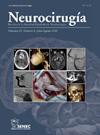Revisión de los fracasos terapéuticos de la descompresión microvascular en la neuralgia del trigémino en un hospital terciario
IF 0.8
4区 医学
Q4 NEUROSCIENCES
引用次数: 0
Abstract
Introduction
Microvascular decompression (MVD) is a non-ablative technique aimed at relieving pain in trigeminal neuralgia (TN) by resolving a neurovascular conflict. Despite reported high success rates, a significant percentage of patients experience therapeutic failure.
Methods
Retrospective observational study of patients with suspected TN undergoing MVD was performed with the goal of identifying factors contributing to the persistence and recurrence of pain.
Results
In the present study, 31 patients undergoing 38 MVD procedures for TN were included (7 patients underwent reoperation after the failure of the initial operation). The mean age was 58.5 years with a male predominance (58.1%). The mean duration of pain was 6.4 years, mainly affecting branches V2 and V3 (46.7%). The most frequently described neurovascular conflict was with the superior cerebellar artery (54.8%), predominantly resolved with Teflon (75.9%).
In our case series, MVD achieved pain control in 80.6% of patients at one-year post-intervention and 61.3% at the end of the follow-up period. Twelve patients experienced MVD failure: 5 cases of persistent pain and 7 cases of pain recurrence. A detailed analysis of these failures identified misdiagnosis as the reason of persistent pain in 4 patients, while inadequate surgical technique could be the cause of pain recurrence in 6 patients.
Conclusion
In our study, therapeutic failures could mainly be attributed to two factors: misdiagnosis or the use of inappropriate materials. These factors should be considered when optimizing the management of DMV in patients with NT.
三级医院微血管减压治疗三叉神经痛失败的回顾
微血管减压(MVD)是一种非消融技术,旨在通过解决神经血管冲突来缓解三叉神经痛(TN)的疼痛。尽管成功率很高,但仍有相当比例的患者经历治疗失败。方法对疑似TN患者进行MVD的回顾性观察研究,目的是找出导致疼痛持续和复发的因素。结果本研究共纳入31例接受38次MVD治疗的患者,其中7例首次手术失败后再次手术。平均年龄58.5岁,男性居多(58.1%)。平均疼痛持续6.4年,主要累及V2和V3分支(46.7%)。最常见的神经血管冲突是小脑上动脉(54.8%),主要是用聚四氟乙烯(75.9%)解决。在我们的病例系列中,80.6%的患者在干预后一年内实现了疼痛控制,61.3%的患者在随访期结束时实现了疼痛控制。12例患者出现MVD衰竭:5例持续疼痛,7例疼痛复发。对这些失败的详细分析发现,误诊是4例患者持续疼痛的原因,而不适当的手术技术可能是6例患者疼痛复发的原因。结论在本研究中,治疗失败的主要原因是误诊或材料使用不当。在优化NT患者的DMV管理时,应考虑这些因素。
本文章由计算机程序翻译,如有差异,请以英文原文为准。
求助全文
约1分钟内获得全文
求助全文
来源期刊

Neurocirugia
医学-神经科学
CiteScore
1.30
自引率
0.00%
发文量
67
审稿时长
60 days
期刊介绍:
Neurocirugía is the official Journal of the Spanish Society of Neurosurgery (SENEC). It is published every 2 months (6 issues per year). Neurocirugía will consider for publication, original clinical and experimental scientific works associated with neurosurgery and other related neurological sciences.
All manuscripts are submitted for review by experts in the field (peer review) and are carried out anonymously (double blind). The Journal accepts works written in Spanish or English.
 求助内容:
求助内容: 应助结果提醒方式:
应助结果提醒方式:


